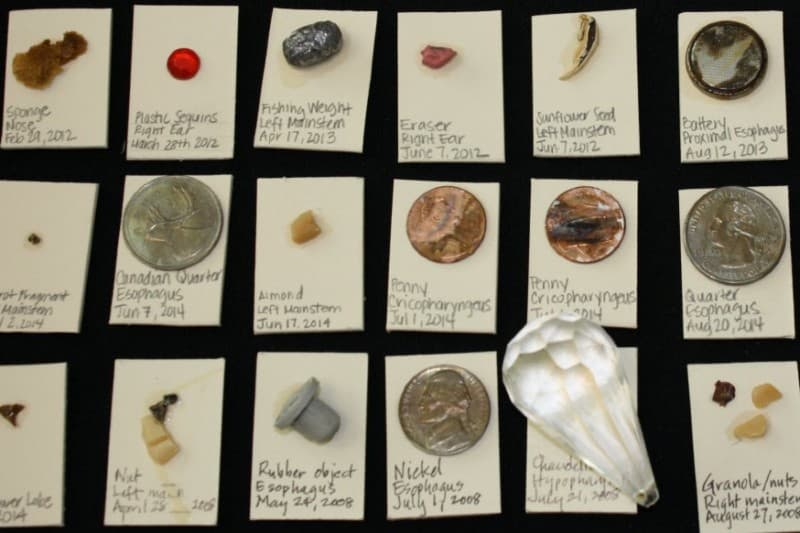Coins, Blow Darts and Button Batteries: The Diary of an Otolaryngologist
4.29.2015 | Seattle Children's Press Team

They say that life is all about the little things, and for the Otolaryngology care team at Seattle Children’s Hospital, this statement holds true more often than not. Each year more than 150 children find their way to the Seattle Children’s Otolaryngology clinic to have some kind of household object, or “foreign body,” removed from their ear, nose or throat.
These objects, while sometimes but not always small, and ranging from coins to button batteries, have become part of a unique collection that hangs in Dr. Kathleen Sie’s office. It’s a collection that she hopes will raise awareness for parents and caregivers about the prevalence of many dangerous household items that often hide in plain sight.
“While these objects in the collection may seem quaint, each one represents an unplanned trip to the doctor’s office or emergency room,” said Sie, an otolaryngologist and surgeon at Seattle Children’s. “In some cases, families get nothing more than a story to tell, but in others these foreign bodies can be the source of a life-threatening, surgical emergency.”
The common culprits through the years
Each time she removes an object from a child’s ear, nose or airway, Sie politely asks that patient’s parent or guardian if she can keep it for her teaching collection. While she admits that “a few interesting objects have gotten away,” most families are more than happy to donate for the sake of public health. What’s interesting about Sie’s collection, which she began keeping in 1992, is that over the years you can see the trends of the removed objects both shift, as well as stay the same.
“In the 90s we saw a lot of safety pins, needles and for a brief while, blow darts,” said Sie. “While those have tapered off a bit, coins, nuts, earrings and other small plastic objects have persisted.”
The dangers of button batteries
If there has been any trend that has been the most alarming for ear, nose and throat specialists, it has been the upswing in the amount of button batteries they have seen over the past decade.
“I started seeing kids ingesting button batteries four or five years ago, and they have become very common in the past couple years,” said Sie. “Because moisture conducts electricity, a battery lodged in a child’s throat or nose triggers an electrical current that causes tissue injury within a few minutes of contact that can cause devastating damage to the esophagus trachea and surrounding structures such as the aorta.”
Button batteries can be found in toys, remote controls, musical greeting cards, key chains and many other electronic items that kids may have access to. The first step in prevention is to identify these objects and keep them out of reach.
If you suspect that your child has ingested a button battery, take them to a healthcare provider immediately for an X-ray. Make sure they do not eat or drink anything until they are seen by a healthcare provider.
Additional advice for caregivers
Coins: While there are many more seemingly dangerous items for parents to worry about, the sheer amount of coins in Sie’s collection suggests that kids tend to gravitate towards the objects they have the most access to. “Coins are the mainstays of the collection for a reason,” said Sie. “Keeping a bin for loose change out of the reach of young children in your home can alleviate a lot of these problems.”
Nuts: Nuts are also a repeat offender in the collection, and Sie advised that parents should wait to serve their children nuts until they are at least 4 or 5 years of age when they have molars to grind the nuts.
Raw vegetables: Parents of babies should avoid feeding their children raw vegetables and should cook or steam them to soften their texture. “Parents and caregivers of children slightly older should also show caution feeding their children firm foods in large chunks,” said Sie.
Sit down for meals: Sitting down for meals not only leads to family bonding, it’s also important for keeping kids safe. “Choking is a leading cause of injury among children, and can often be fatal in children 4 years of age or younger,” said Sie. “Kids are much more likely to choke if they’re active while eating, which is why parents and caregivers should stress to children that moving around and eating should not mix. Sitting down for a meal establishes safe eating habits and you get to spend time together, so everybody wins.”